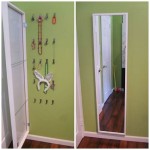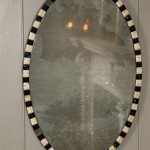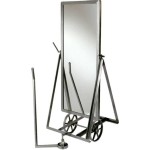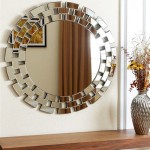What Is The Little Mirror In A Car Called?
The small, adjustable mirror located inside a vehicle, typically attached to the windshield or headliner, is formally called the
rearview mirror
orinside rearview mirror
. While sometimes referred to as the "day/night mirror" due to its common anti-glare functionality, the official term remains rearview mirror.The primary purpose of the rearview mirror is to provide the driver with a direct view of the traffic and conditions behind the vehicle. This allows the driver to monitor approaching vehicles, assess safe passing opportunities, and maintain overall situational awareness of the surrounding traffic flow.
The rearview mirror's design is relatively simple, consisting of a reflective surface, typically made of glass, mounted on an adjustable pivot. This pivot mechanism allows drivers to customize the mirror's angle to achieve optimal visibility based on their seating position and vehicle dimensions.
Many modern rearview mirrors feature a "day/night" or anti-glare function. This feature reduces the glare from headlights of trailing vehicles during nighttime driving. Traditional day/night mirrors accomplish this through a prism-based mechanism controlled by a small tab on the bottom edge of the mirror. Flipping the tab changes the angle of the reflected light, reducing the intensity of bright headlights. More advanced auto-dimming rearview mirrors use electrochromic technology. These mirrors contain a gel that darkens automatically in response to detected glare, providing a seamless transition between day and night modes.
The legal requirements for rearview mirrors vary by jurisdiction. Most regions mandate a functioning inside rearview mirror as a minimum requirement for road legality. Some jurisdictions may also specify minimum dimensions or reflectivity standards for the mirror.
Proper adjustment of the rearview mirror is essential for safe driving. The mirror should be positioned so that the driver can see the entire rear window of the vehicle, providing the widest possible field of view. This minimizes blind spots and allows the driver to quickly assess the traffic situation behind them. The driver's head should not have to move significantly to get a clear view in the mirror.
While the rearview mirror offers a valuable perspective of the area behind the vehicle, it does have limitations. The field of view is restricted to what can be seen through the rear window, creating blind spots to the sides and rear corners of the car. These blind spots necessitate the use of external side mirrors and regular shoulder checks before changing lanes or making other maneuvers.
Historically, rearview mirrors have evolved significantly. Early automobiles often lacked a rearview mirror altogether, relying solely on driver awareness and occasional glances over the shoulder. As vehicle speeds increased and traffic density grew, the need for a dedicated rearview mirror became apparent. Early versions were simple, fixed mirrors offering a limited field of view. Over time, the design evolved to incorporate adjustable mounts, larger reflective surfaces, and eventually, anti-glare technology.
Beyond their primary safety function, rearview mirrors have become integrated with other vehicle systems. Some models incorporate built-in compass displays, temperature sensors, or even map lights. Higher-end vehicles often feature integrated backup cameras that display their feed on the rearview mirror screen when the car is placed in reverse. This provides an enhanced view of the area directly behind the car, assisting with parking and other low-speed maneuvers.
Maintaining a clean and unobstructed rearview mirror is crucial for optimal visibility. Regularly cleaning the mirror surface will remove dust, fingerprints, and other debris that can impede the driver's view. Obstructions hanging from the rearview mirror, such as air fresheners or decorations, should be kept to a minimum to avoid obstructing the field of view. Minimizing these obstructions can significantly improve the driver's situational awareness and contribute to safer driving practices.
The development of advanced driver-assistance systems (ADAS) has further integrated the rearview mirror into the vehicle's safety network. Systems like lane departure warning, adaptive cruise control, and automatic emergency braking may utilize information gathered from cameras or sensors integrated with or located near the rearview mirror. These systems enhance driver awareness and can actively intervene to prevent collisions.
While technology continues to advance, the fundamental purpose of the rearview mirror remains constant: providing the driver with a clear view of the traffic behind them. This seemingly simple device plays a vital role in road safety, enabling drivers to make informed decisions and navigate traffic flow effectively. Its ongoing evolution reflects the automotive industry's commitment to enhancing driver visibility and promoting safer roads for all.

Why The Side Mirrors Majorly Of All Heavy Vehicles Are Small In Size Quora

Why Is There A Mirror Near The Driver S Seat In Car Quora

What Are The Mirrors Called In A Car Learn Automatic
I Ve Got A New Sunshade For My Car Windshield Reflective Side And Pretty Which Should Face The Sun Quora

What Are The Mirrors Called In A Car Learn Automatic
If All Cars Have Blind Spots Why Don T They Make The Side View Mirrors That Show Those Quora
Car 360 Wide Angle Round Convex Mirror Vehicle Side Blindspot Blind Spot Rear View Small Ee Es

Zopa Small Rear View Mirror Mari Kali S Cyprus
2pcs Car Blind Spot Mirror Frameless Auxiliary Rearview Auto Motorcycle Universal Wide Angle Adjustable Small Mirrors Ee Singapore

Zopa Small Rear View Mirror Mari Kali S Cyprus








